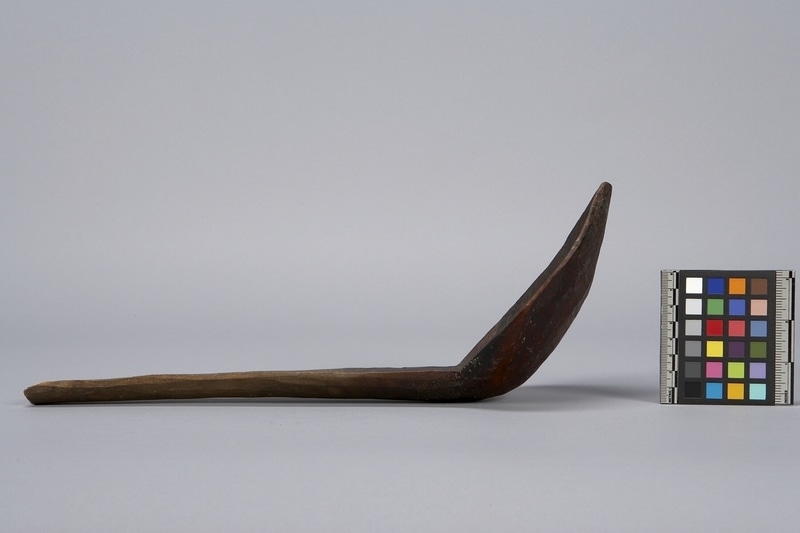Ladle Item Number: A8236 from the MOA: University of British Columbia


Description
Wooden ladle with leaf-shaped bowl and long handle with squared end. The handle becomes narrower towards the top and has an oval shaped indentation at its base. The underside of the ladle's bowl slopes to reach a gentle centre point. Many tools marks are visible on the inside of the bowl, which may have been coated with a grease or oil substance. The ladle is dark reddish-brown.
History Of Use
Ladles were used for serving food, and this one with its greasy residue was likely used for serving oil. Fish oil was a traditional staple in the Coast Salish diet. Homer Barnett, for example, notes that: "the regular diet consisted of dried foods, principally salmon, clams and fish eggs, all of which were dipped in seal, porpoise, or fish oil (1955:60). " He adds that: "the blubber of fish was boiled until the oil was released and floated on the surface of the water. It was then skimmed off with ladles and when cool put into the stomach sacks of seals or sea lions for storage (1955:61)." Eulachon, a fish prized along the Pacific Northwest for its oil, was available only along the Squamish and Homathko rivers. "The Comox and the Pentlatch [of eastern Vancouver Island] used the oil of this fish but had to obtain it by trade with groups to the north. The others did without it (1955:67)."
Cultural Context
household utensil; domestic
Specific Techniques
Homer Barnett notes that spoons were generally made of wood. Maple was the preferred wood, alder was sometimes used but cracked badly, while red cedar imparted a flavor to the food. The handles of wooden spoons were often decorated with animal figures, such as sea lions, seals, and ducks. The eyes and teeth of the animals were often inlaid with haliotis shell. Bill Holm notes that: "wooden spoons are closely related in form to horn spoons, although the manner of making each type is different in concept and technique. The horn spoon, whether from the massive, spiral horn of the mountain sheep or the slim, black dagger-like horn of the mountain goat is cut from the partially hollow, curved material and brought to its final form by steaming and then spreading the bowl and bending the handle. Wooden spoons, on the other hand, are carved to shape from solid blocks of wood. The shape of the material and the techniques of manufacture of each type of spoon influences its final shape, and yet the two types are nearly identical in form (1987:90)." Wooden spoons can be differentiated from horn spoons since they exhibit the concentric growth patterns of wood, while the fibres of horn are arranged in a parallel manner.
Narrative
Said to have been collected by Donald MacKay while he was the Indian Commissioner for BC, 1937-1948.
Item History
- Made in British Columbia, Canada
- Collected between 1937 and 1948
- Owned by Donald M. MacKay
- Owned by Marion MacKay before February 13, 1961
- Received from Marion MacKay (Seller) and H. R. MacMillan (Funding source) on February 13, 1961
What
Who
- Culture
- Coast Salish ?
- Previous Owner
- Donald M. MacKay and Marion MacKay
- Received from
- Marion MacKay (Seller) and H. R. MacMillan (Funding source)
Where
- Holding Institution
- MOA: University of British Columbia
- Made in
- British Columbia, Canada
When
- Collection Date
- between 1937 and 1948
- Ownership Date
- before February 13, 1961
- Acquisition Date
- on February 13, 1961
Other
- Condition
- fair
- Current Location
- Case 7
- Accession Number
- 0044/0062